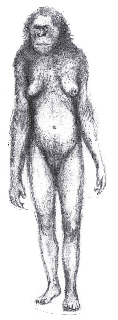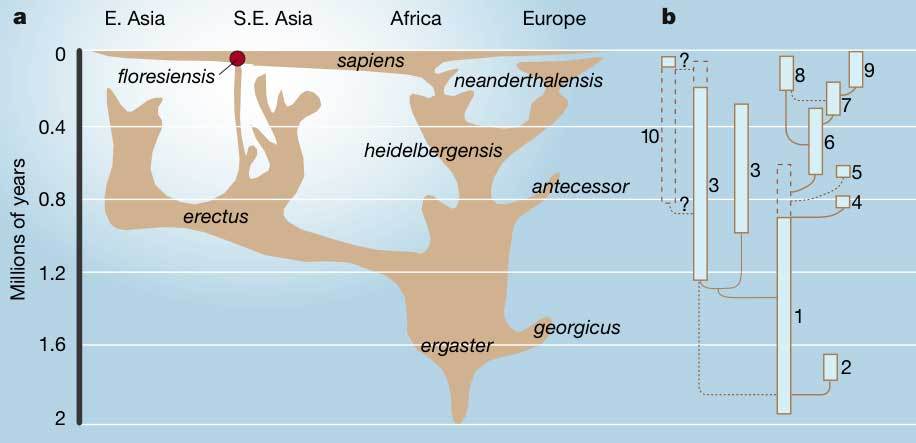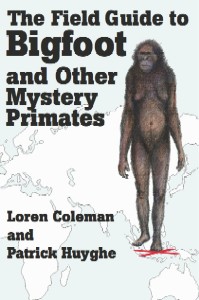Hobbits Not Diseased, Notes Dec. 2009 Study
Posted by: Loren Coleman on November 21st, 2009
Hopefully a new study being published in December 2009 will be the final nail in the coffin of all those arguments attempting to debunk the Hobbits, Homo floresiensis, and ignore the reality that a population of very small hominoids lived concurrently with Homo sapiens. Stories of the “little people” have some basis in fact. Period.


The male National Geographic painting of the first Homo foresiensis find, compared to Richard Klyver’s sketch of the Flores woman. The first fossil discovery of Homo floresiensis was of a female, not a male, please note.
“The discovery that Homo floresiensis survived until so very recently, in geological terms, makes it more likely that stories of other mythical, human-like creatures such as Yetis are founded on grains of truth….Now, cryptozoology, the study of such fabulous creatures, can come in from the cold.”
~ Henry Gee, editor of Nature, “Flores, God and Cryptozoology,” 2004 editorial.

Researchers from Stony Brook University Medical Center in New York have confirmed that Homo floresiensis is a genuine ancient human species and not a descendant of healthy humans dwarfed by disease. Using statistical analysis on skeletal remains of a well-preserved female specimen, researchers determined the “hobbit” to be a distinct species and not a genetically flawed version of modern humans.
Details of the study appear in the December issue of Significance, the magazine of the Royal Statistical Society, published by Wiley-Blackwell.
In 2003 Australian and Indonesian scientists discovered small-bodied, small-brained, hominin (human-like) fossils on the remote island of Flores in the Indonesian archipelago. This discovery of a new human species called Homo floresiensis has spawned much debate with some researchers claiming that the small creatures are really modern humans whose tiny head and brain are the result of a medical condition called microcephaly.
Researchers William Jungers, Ph.D., and Karen Baab, Ph.D. studied the skeletal remains of a female (LB1), nicknamed “Little Lady of Flores” or “Flo” to confirm the evolutionary path of the hobbit species. The specimen was remarkably complete and included skull, jaw, arms, legs, hands, and feet that provided researchers with integrated information from an individual fossil.
The cranial capacity of LB1 was just over 400 cm, making it more similar to the brains of a chimpanzee or bipedal “ape-men” of East and South Africa. The skull and jawbone features are much more primitive looking than any normal modern human. Statistical analysis of skull shapes show
modern humans cluster together in one group, microcephalic humans in another and the hobbit along with ancient hominins in a third.
Due to the relative completeness of fossil remains for LB1, the scientists were able to reconstruct a reliable body design that was unlike any modern human. The thigh bone and shin bone of LB1 are much shorter than modern humans including Central African pygmies, South African KhoeSan (formerly known as ‘bushmen”) and “negrito” pygmies from the Andaman Islands and the Philippines. Some researchers speculate this could represent an evolutionary reversal correlated with “island dwarfing.” “It is difficult to believe an evolutionary change would lead to less economical movement,” said Dr. Jungers. “It makes little sense that this species re-evolved shorter thighs and legs because long hind limbs improve bipedal walking. We suspect that these are primitive retentions instead.”
Further analysis of the remains using a regression equation developed by Dr. Jungers indicates that LB1 was approximately 106 cm tall (3 feet, 6 inches) — far smaller than the modern pygmies whose adults grow to less than 150 cm (4 feet, 11 inches). A scatterplot depicts LB1 far outside the range of Southeast Asian and African pygmies in both absolute height and body mass indices. “Attempts to dismiss the hobbits as pathological people have failed repeatedly because the medical diagnoses of dwarfing syndromes and microcephaly bear no resemblance to the unique anatomy of Homo floresiensis,” noted Dr. Baab.

The front cover of The Field Guide to Bigfoot and Other Mystery Primates is illustrated with a drawing of Homo floresiensis by wildlife artist Richard Klyver, who studied for seven years among chimpanzees in Africa.
Local natives on Flores have one hundred year old legends of a small hairy people, the Ebu Gogo, and clues from these tales will be employed to find new caves to explore for evidence of their former little habitants. While Sumatra’s Orang Pendek has been mentioned in the same context as the media nicknamed ‘Hobbits’ of Flores, the more relevant cryptids are not anthropoids, but the fully manlike ones, such as the Nittaewo, the three feet tall hairy hominids of ancient Ceylon (Sri Lanka) — mentioned by Pliny in the first century — who were said to exist to the end of the 18th Century. It is time to look again at reports of little people, with an eye to the discovery of their subfossil remains and living existence, from Sri Lanka to the South Pacific.Loren Coleman, 2004
The 900-2,800-year-old “insular dwarf” remains from Palau seem to confirm traditions of “Little People” 2 or 3 feet tall from various Pacific islands. The best-known of these Pacific “Little People,” of course, are the Menehune of Hawaii. They are usually described as 2 to 3 feet tall, with short, stout, hairy, and quite muscular bodies, red-skinned faces, big eyes hidden by long eyebrows, low protruding foreheads, and short thick noses.
However, Menehune-like dwarfs have also been reported from other Pacific islands. Thus, six witnesses in a Fijian mid-afternoon encounter in 1975 described seeing eight figures, 2 feet tall and covered with black hair, run and disappear behind some bushes (Fiji Times, July 19, 1975, cited by Loren Coleman and Patrick Huyghe, The Field Guide to Bigfoot and Other Mystery Primates , p. 148).T. Peter Park, 2008
About Loren Coleman
Loren Coleman is one of the world’s leading cryptozoologists, some say “the” leading living cryptozoologist. Certainly, he is acknowledged as the current living American researcher and writer who has most popularized cryptozoology in the late 20th and early 21st centuries.
Starting his fieldwork and investigations in 1960, after traveling and trekking extensively in pursuit of cryptozoological mysteries, Coleman began writing to share his experiences in 1969. An honorary member of Ivan T. Sanderson’s Society for the Investigation of the Unexplained in the 1970s, Coleman has been bestowed with similar honorary memberships of the North Idaho College Cryptozoology Club in 1983, and in subsequent years, that of the British Columbia Scientific Cryptozoology Club, CryptoSafari International, and other international organizations. He was also a Life Member and Benefactor of the International Society of Cryptozoology (now-defunct).
Loren Coleman’s daily blog, as a member of the Cryptomundo Team, served as an ongoing avenue of communication for the ever-growing body of cryptozoo news from 2005 through 2013. He returned as an infrequent contributor beginning Halloween week of 2015.
Coleman is the founder in 2003, and current director of the International Cryptozoology Museum in Portland, Maine.










Excellent thread and post, Loren. Finally evidence that shows that there is more to our history than we’ve been taught in School. 🙂
Check with any elderly Native American who still lives on their respective reservation today, and they will tell you that the little people are still alive today, all across the US. And those little people have identical evasive skills as the Sasquatch. Evasive skills of which are pretty much without ordinary limits. Some of those little people make and wear their own clothes and some have no clothes at all. Although they have been diminshed somewhat by storytellers as often being referred to as mythical, they are as real as any animal or Bigfoot in the forest.
Western scientists still won’t believe in the local peoples’ sightings of modern versions of such a creature (e.g. Orang Pendek) because they haven’t seen one themselves. How could people in the South Seas or China or Russia or India or North America or Australia possibly know what kind of creatures live in local forests? Must be superstition or a bear because after all “We (Western Science) know they went extinct thousands of years ago,” they would say.
http://www.is-bigfoot-real.com/
Cryptomundo » Hobbits Not Diseased, Notes Dec. 2009 Study